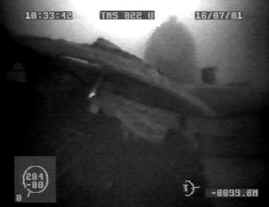
Mon, Jul 23 05:46 AM
This handout television still released July 23, 2001, by the Rubin construction centre shows the Russian nuclear submarine Kursk lying at the bottom of the Barents Sea. Divers began cutting holes on July 22 in the hull of the sunken nuclear-powered submarine Kursk, to fix cables that will eventially be used to hoist it to the surface. BEST QUALITY AVAILABLE REUTERS/Rubin/Handout (Reuters)
MOSCOW (Reuters) - The Russian navy said on Friday a plan to raise the Kursk nuclear submarine from the bottom of the Barents Sea hit a snag when deep-sea divers had trouble cutting through the craft's hull.
Vice Admiral Mikhail Motsak, coordinating the recovery operation, said on Russian television that an international team of divers had run into problems while making holes in the craft to affix cables and eventually haul the sub up.
"Everything looked fine on paper and when testing the equipment on the surface. But under water everything turned out to be more complex because the company did not have their equipment tuned for the type of steel of our vessel."
After a series of unexplained explosions, the Kursk sank last August with the loss of all 118 people on board. President Vladimir Putin has vowed to raise the craft and dispose of its nuclear reactors.
The Russian navy is conducting the project with Dutch heavy transport firm Mammoet, salvage company Smit and Norwegian outfit Norse Cutting and Abandonment. All three companies were unavailable for comment on Friday.
Russia cannot afford serious delays to a salvage project it aims to complete by September 20, before severe winter weather again engulfs the Arctic site of the disaster.
Igor Spassky, the head of the contractor, Rubin, which designed the Kursk, said on Friday that it would cost a total of about $130 million to raise the ship, with Mammoet and its partners receiving about $65 million.